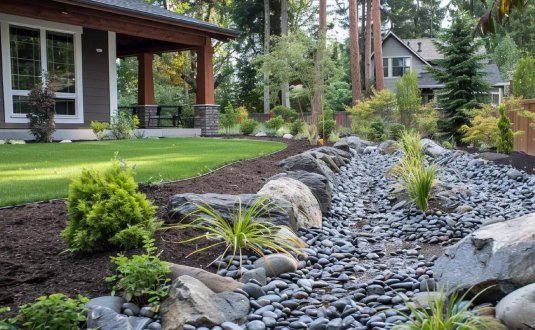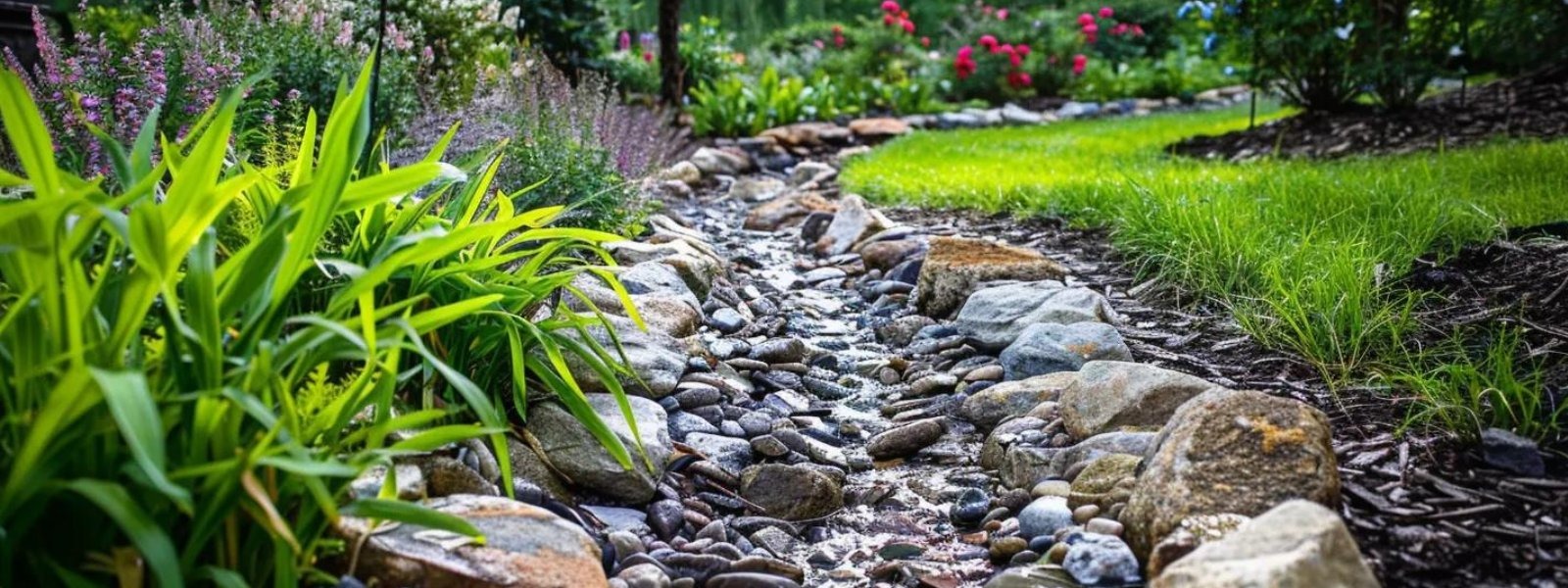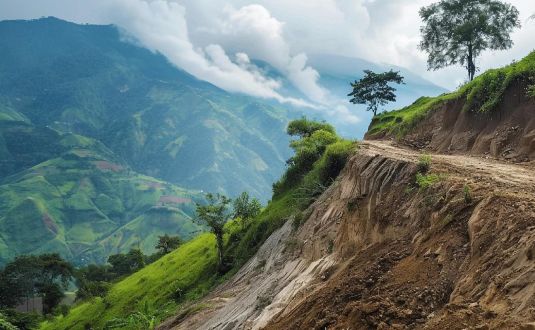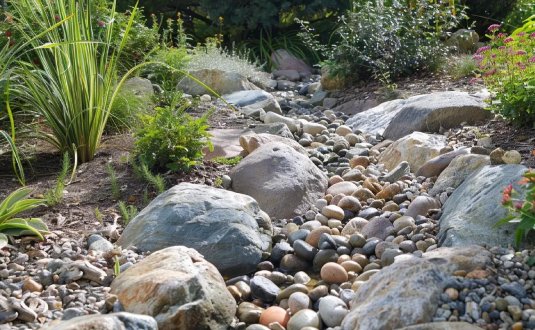Providing Best Services in Huntsville, AL
Providing Best Landscaping Services in Huntsville, AL



.webp)
French Drains or Dry Creek Beds: Which One Is Right ?
Both French drains and dry creek beds work great to move water away from your home. French drains work underground to catch hidden water. Dry creek beds sit on top of the ground and look like a pretty stream. The best choice depends on where your water problem is and what you want your yard to look like.
Both French drains and dry creek beds work great to move water away from your home. French drains work underground to catch hidden water. Dry creek beds sit on top of the ground and look like a pretty stream. The best choice depends on where your water problem is and what you want your yard to look like.
What Is a French Drain?
A French drain is a hidden system that moves water underground. You dig a trench, put in a special pipe with holes, and cover it with rocks and dirt. The water goes into the pipe and flows away from your home.
How French Drains Work
French drains catch water that soaks into the ground. The pipe has tiny holes that let water in. Rocks around the pipe keep dirt out but let water flow through. The water travels through the pipe to a safe spot away from your house.
The way it works is pretty simple. Water naturally wants to take the easiest path. When you put in rocks and a pipe with holes, you're creating that easy path. The water finds your drain instead of pushing against your basement walls.
Where French Drains Work Best
French drains fix problems with underground water. They work around your home's base to protect your basement. They help near walls that hold back dirt. In flat yards where water sits, they give it somewhere to go.
If you're dealing with water that threatens your home's foundation, a French drain is usually your answer. It's like giving water a highway to travel on instead of letting it wander wherever it wants.
What French Drains Cost
Installing a French drain costs money because it takes more work. Most people pay between $20 to $30 for each foot of drain. For a 100-foot drain, you'll spend about $2,000 to $3,000.
The price goes up if your drain goes deep underground, you have hard dirt like clay, workers need to break up concrete in your basement, or you add a pump to move the water.
Inside basement drains cost more, usually $40 to $100 per foot. This is because workers have to dig up your basement floor. They need special equipment and it takes longer to finish the job.
Benefits and Drawbacks
French drains have some great benefits. They stay hidden under your grass or dirt, so your yard looks normal. They need very little care after you put them in. They protect your home's base really well from water damage. They handle lots of water at once during heavy storms.
The downsides are they cost more money to put in than other options. You can't see them, so they don't add beauty to your yard. If they get clogged with dirt or roots, fixing them is hard because you have to dig them up.
What Is a Dry Creek Bed?

A dry creek bed looks like a stream running through your yard, but it only has water when it rains. You dig a shallow path and fill it with rocks and stones. Some people add plants and big boulders to make it look natural.
How Dry Creek Beds Work
When it rains, water flows into your creek bed and follows the path you made. The rocks slow the water down and guide it where you want it to go. Between storms, your creek bed sits empty and looks like a pretty part of your garden.
Think of it like making a road for water. Instead of water running wild and washing away your plants and dirt, it follows the path you created. The rocks hold everything in place.
Where Dry Creek Beds Work Best
Dry creek beds fix problems with water on top of the ground. They work great on sloped yards to stop dirt from washing away. Under spots where water pours off your roof, they catch the flow. In places where water makes muddy puddles, they move it along.
Many Huntsville homeowners use creek beds to solve problems with muddy yards that happen after every rain. The clay soil in our area doesn't absorb water quickly, so surface drainage becomes really important.
What Dry Creek Beds Cost
Dry creek beds cost less than French drains. Most people pay between $5 to $7 for each foot. For a 20-foot creek bed that's 4 feet wide, you'll spend about $400 to $560 for the rocks.
The price can go up if you add extra big boulders, which are rocks bigger than 12 inches. Special plants along the sides add to the cost. A small bridge to walk across looks nice but costs more.
Benefits and Drawbacks
Dry creek beds give you lots of benefits. They look beautiful in your yard and become a feature people notice. They cost less money to put in than underground systems. You can make them look however you want with different rocks and plants. They turn a problem into something pretty to look at.
The limits are they only work for water on top of the ground, not underground seepage. You have to keep weeds from growing in them. They take up space in your yard. They might need fixing after big storms if rocks wash out of place.
How to Choose the Right One for Your Yard
Think about where your water problem is. If water sits on top of your grass, a dry creek bed will work. If water leaks into your basement or makes your crawl space wet, you need a French drain.
Consider Your Water Problem Type
Look at when and where you see water. Does it pool on the surface after rain? Does your basement smell damp even when it hasn't rained? Do you see water stains on basement walls? These clues tell you what kind of drainage you need.
Small puddles and wet spots work fine with a dry creek bed. Big water problems that threaten your home's foundation need professional help with proper drainage solutions.
Think About Your Yard's Slope
Sloped yards work great with dry creek beds because water already wants to flow downhill. Flat yards often need French drains to move water along since gravity doesn't help as much.
You can check your slope by watching where water goes when it rains. If it runs downhill naturally, you can work with that flow. If it just sits there, you need something that creates flow underground.
Factor in Your Budget
Dry creek beds cost less, sometimes 4 to 5 times cheaper than French drains. If you're watching your budget, start with a dry creek bed. You can always add a French drain later if needed.
Remember that prevention costs less than repair. A drainage system might seem expensive now, but fixing water damage to your foundation costs way more.
Common Problems Each One Fixes
Wet Basements and Foundation Issues
According to hydrology experts, 75% of basement water problems come from bad roof drainage. But French drains catch the underground water that gutters miss. They work around your basement walls to keep water out.
Many people in the Huntsville area deal with this. The area gets good rain throughout the year, and clay soil holds water instead of draining it away. A French drain moves that water away before it becomes a problem.
Water against your foundation isn't just annoying. It can crack concrete, make walls bow inward, create mold and mildew problems, and attract bugs like mosquitoes. French drains stop all these issues by removing the water.
Standing Water Near Your Home
Standing water near your foundation causes big trouble over time. The constant moisture weakens concrete. Pressure builds up and pushes against walls. In winter, water freezes and expands, making cracks worse.
French drains catch this water and send it away before damage starts. Many contractors install them during new construction to prevent problems from ever starting. If you have walls holding back dirt, water builds up behind them. French drains release this pressure by giving water a place to go.
Erosion on Sloped Yards
Water running down hills washes away your dirt and plants. This creates ugly bare spots and gullies that get deeper every time it rains. A dry creek bed gives water a safe path to follow.
If you're dealing with serious problems from yard erosion on slopes around your property, a dry creek bed might be your best answer. It works with gravity instead of fighting it, making it very effective on hillsides.
The rocks also look natural on a slope. You can arrange them to look like a mountain stream, which fits the landscape perfectly. Add some native plants and it looks like it's been there forever.
Muddy Spots and Water Pooling
Some areas stay muddy even when it hasn't rained much. This happens when water from your downspouts or driveway collects in one place. A dry creek bed guides that water away and stops the mud from forming.
Clay soil makes this problem worse in our area. The soil doesn't drain well, so water sits on top and turns into a muddy mess. A creek bed with good rock base allows some water to soak through while moving the rest along.
Installing French Drains
The Installation Process
Putting in a French drain takes several steps and some planning. First, workers plan the path and figure out where water needs to go. They dig the trench deep enough to catch water but not so deep they hit utility lines. They add fabric at the bottom to keep dirt out of the pipe. They put in the pipe with holes facing down. They cover everything with rocks to fill the trench.
Most jobs take one to three days depending on how long the drain needs to be. Complex systems that go around your whole house take longer. Simple drains that just fix one problem area go faster.
The hardest part is getting the slope right. Water won't flow if the pipe is level or tilts the wrong way. Professional installers use special tools to check the slope as they work.
Hiring a Professional
French drains need special skills that most homeowners don't have. You have to figure out which way water should flow based on your yard's natural slope. You must avoid pipes, wires, and cables underground. You have to make sure the slope is right or water won't flow.
Most people hire a professional for this work. Experts who handle landscaping installation know how to check for buried utilities before digging. They have the right equipment to dig efficiently. They understand drainage patterns and can spot potential problems.
The small amount you might save doing it yourself isn't worth the risk of doing it wrong. A poorly installed French drain doesn't work and you'll have to pay someone to fix it anyway.
Maintenance Needs
French drains need very little care once they're in. Check the outlet once a year to make sure water flows out freely. Watch for soft spots in your yard that might mean the pipe broke. Keep tree roots away from the drain area because roots can break pipes searching for water.
If your drain stops working, you might need to flush it out with water pressure or replace a section. But most drains work for decades without any problems.
Installing Dry Creek Beds
The Installation Process
Making a dry creek bed is simpler than installing a French drain. You start by marking your path with paint or string to show where it goes. You dig the trench about six to nine inches deep following the natural slope. You add landscape fabric at the bottom to stop weeds from growing up through the rocks. You place big rocks first along the edges to hold everything in place. You fill the middle with smaller river rocks in different sizes.
Most creek beds can be done in one to two days. The exact time depends on how long your creek bed is and whether you're doing elaborate designs with multiple types of rocks.
DIY or Hire Help
Some people do their own dry creek beds successfully. You need a shovel for digging, landscape fabric to prevent weeds, lots of rocks that are heavier than you think, and some muscle power to move everything around.
The hard part is moving all those rocks. One homeowner said they used eight tons of rock for two creek beds. That's as heavy as three cars. Most people underestimate how much rock they need and how heavy it is.
Working with someone who specializes in landscaping design helps you plan the best path and choose rocks that look good together. They can also suggest plants that will thrive along the edges.
Ongoing Maintenance
Dry creek beds need more care than French drains but it's not difficult. Pull weeds that grow between rocks a few times each year. Replace fabric if it tears or wears through. Add more rocks if some wash away during heavy storms. Trim plants so they don't take over the whole creek bed.
Some people use weed killer to keep maintenance easy. Others prefer to pull weeds by hand to keep chemicals out of their yard. Either way works fine.
Using Both Together
Sometimes you need both systems working together. Put a French drain around your basement to handle underground water. Add a dry creek bed in your yard for surface water and looks. Connect them so they work as a team to protect your property.
This gives you full protection plus something pretty to look at. The French drain handles serious water problems underground where they threaten your foundation. The dry creek bed takes care of surface water and looks good doing it.
This combination works great for homes with both basement water and yard drainage issues. Many properties in areas with clay soil need this dual approach because water comes from above and below.
Other Drainage Options to Consider
French drains and dry creek beds aren't your only choices. Catch basins work like underground buckets with grates on top. They catch water in one spot and send it through pipes to other areas.
Sometimes you just need to change the slope of your yard through grading. Water naturally flows downhill, so making your yard tilt away from your house helps a lot.
- Channel drains are long grates that you see on driveways and catch water as it flows across hard surfaces
- Rain gardens are low spots filled with plants that love water and soak up rain naturally while looking beautiful
The right choice depends on your specific yard and problems. A drainage expert can look at your property and suggest the best mix of solutions. Sometimes fixing issues with standing water requires combining several different approaches.
Working With Alabama Soil
Alabama soil can be tricky for drainage. Most of our area has clay soil that doesn't drain well naturally. This makes water problems worse than they would be in sandy soil.
Understanding Clay Soil
Clay holds water like a sponge that never fully dries out. When it gets wet, it swells up and becomes heavy. When it dries, it shrinks and cracks. This constant change can crack your foundation over time. It makes water pool on top of the ground because it can't soak in.
Both French drains and dry creek beds help with clay soil issues. French drains give water an easy path through the clay to get away from your house. Dry creek beds keep water from sitting on top where it causes mud and erosion.
Improving Soil Drainage
Sometimes you need to fix your soil along with adding drainage. Getting help with soil amendment and repair improves water drainage throughout your whole yard, not just in one area.
Adding organic matter like compost makes clay soil drain faster. Mixing in sand can help too, though you need a lot of it to make a real difference. These improvements work alongside your drainage systems to create better conditions.
Making Your Drainage Beautiful

Drainage doesn't have to be ugly or purely functional. Even if you pick a French drain that stays hidden, you can add pretty touches around it. Think about the whole picture of your yard, not just the drainage problem.
Combining Drainage With Landscape Design
Work with professionals who understand both drainage and beauty. They can hide French drain outlets with carefully chosen plants that thrive in moist conditions. They can make dry creek beds the star of your garden with thoughtful rock selection and placement. They can add features through hardscaping like pathways and patios that work with your drainage instead of fighting it.
Good design makes everything work together. Your drainage system becomes part of the overall landscape plan instead of an afterthought or eyesore.
Creating Visual Interest
Turn your creek bed into a feature people stop to admire when they visit. Use different colored rocks to create visual interest. Add a small wooden bridge to walk over the creek bed. Place interesting boulders as focal points that draw the eye. Plant flowers along the edges in colors that stand out.
Some people add water features like small fountains at one end of their creek bed. This gives you the sound of water even when it's not raining. Others incorporate the creek bed into a larger garden theme, like a Japanese-style garden or a natural woodland setting.
Frequently Asked Questions
How long do French Drains Last?
Good French drains last 20 to 30 years or more when installed correctly. The pipe itself can last even longer than that. The rocks around it might need cleaning or replacing over time if dirt gets through the fabric. Regular maintenance like checking for clogs helps them last longer.
Can I Install a Dry Creek Bed Myself?
Yes, you can install a dry creek bed yourself if you're comfortable with physical work. You'll need basic tools like a shovel and landscape fabric. The hardest part is moving all the rocks, which are much heavier than most people expect. Many homeowners hire help just for placing the large boulders, then finish the smaller rocks themselves.
Do These Drainage Systems Work in Winter?
Yes, both systems work year-round including winter months. They handle melting snow just like they handle rain. French drains keep working underground even when the ground freezes on top. Dry creek beds manage snow melt and ice runoff. Just make sure ice or frozen debris doesn't block the path in your creek bed.
Which Option is Better for Steep Slopes?
Dry creek beds usually work better on steep slopes because they work with gravity. Water naturally flows downhill fast on slopes, and the creek bed guides it safely. The rocks prevent erosion while letting water move quickly. French drains can work on slopes too, but they're harder to install because you need to maintain the right angle for the pipe.
Will a French Drain Damage Tree Roots?
A French drain won't damage existing tree roots if installed properly. Professional installers dig around major roots when possible. However, you should keep trees at least 10 to 15 feet away from French drains. Tree roots naturally grow toward water sources and can eventually break into the pipe if planted too close.
Final Thoughts
Both French drains and dry creek beds solve water problems, but they do it in different ways. French drains work underground to protect your foundation and basement from serious water damage. They cost more and stay hidden, but they handle the most serious water issues that can harm your home. Dry creek beds work on the surface to control runoff and prevent erosion. They cost less and look beautiful, making them both practical and pretty additions to your landscape.
The best choice depends on where your water problem originates, how much you want to spend, and what you want your yard to look like overall. Many homes actually need both types to fully protect against water damage from different sources.
Don't wait until water damages your home to take action. Fixing drainage problems now saves you thousands of dollars and lots of stress later. Foundation repairs cost far more than drainage systems. Mold remediation is expensive and unpleasant. Basement flooding can destroy belongings you can't replace.
Whether you pick a French drain, a dry creek bed, or both working together, you're making a smart choice for your property's long-term health and value. Good drainage protects your investment and makes your yard more enjoyable.
Talk to drainage experts who know Alabama soil and weather patterns. They'll help you pick the right solution and install it correctly the first time. They can spot problems you might miss and suggest improvements you haven't thought of. Your home and your yard will thank you for taking drainage seriously.
Stay Connected and Inspired
Get the latest landscaping tips, seasonal care guides, and exclusive offers delivered straight to your inbox. Don’t miss out on expert advice and ideas to transform your outdoor spaces.
Sign Up for Our Newsletter Today!


Your Next Idea Awaits
Stay inspired with our latest landscaping tips and trends.
.webp)
.webp)

.webp)
.webp)
.webp)
.webp)
.webp)

.webp)








.webp)
.webp)





